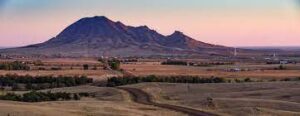South Dakota Travels: Bear Butte
South Dakota Travels: Bear Butte
By Joseph Budd
Native Sun News Today Staff Writer
For most people, a trip to South Dakota checks off the usual suspects. But for the indigenous people, the key, sits to the north and east of Sturgis, a large butte that actually can be seen, just north of Rapid City.
Bear Butte, located off Hwy 79 from Sturgis and I-90, is considered by many a religious site, and has been so for centuries. Some research, even shows artifacts near the site, dating back 10,000 years. Religious ceremonies do take place on the Butte, and a natural observer hiking to the summit will likely see offerings of prayer cloths or bundles of tobacco tied to branches. Looking back into history, the Butte also had visits from Red Cloud, Crazy Horse and Sitting Bull, and in 1857 a council of Indian nations gathered here, to discuss the growing presence of white settlers in the Black Hills.
A bit of irony, after George Custer violated the treaty of 1868 by leading an expedition in 1874, to confirm the presence of gold in the black hills, and the Butte became a familiar landmark for travelers to the Black Hills.
The first efforts to maintain the Butte and establish a park status was set up by a homesteader who had settled on the southern slopes of the mountain. During World War II, a band of Northern Cheyenne approaches Ezra Bovee about a ceremony at Bear Butte to pray for an end to World War II. Over the years, the Bovees continues to encourage these ceremonies.
When Ezra passed away, the state first made the lands nearby into a State part, in 1961, then the Butte was listed as a National Historic Landmark in 1981.
The Butte was also a key location for Frank Fools Crow, a Lakota Ceremonial Chief who would make pilgrimages to the Butte, during his lifetime. He would promote racial harmony between Native Americans and Whites, but also among other people of the world. He also reiterated the statement, that the Black Hills should never be sold. A Bust and Plaque in front of the education center, at Bear Butte State Park, honors his efforts.
Fools Crow, would be instrumental in leading efforts to gain access for Native Americans to sacred lands, through the American Indian Religious Freedom Act of 1978. Based off of the court case Fools Crow vs Gullett, related to the introduction of limits on when and how long Lakota and Cheyenne religious ceremonies could take place at the Butte. While Fools Crow was unable to achieve their singular goal, of having Bear Butte remain untouched as it was sacred, it did cause folks to understand the religious ties Native Americans had to the Butte.
Most recently, between 2016 and 2018, several tribe have been buying up lots of land around the Butte, due to the cultural significance.
So this summer, when travelling, stop by, have a hike, and offer up a prayer…you’re in good company with family.
The post South Dakota Travels: Bear Butte first appeared on Native Sun News Today.

